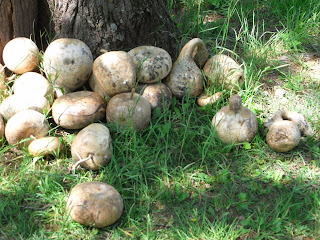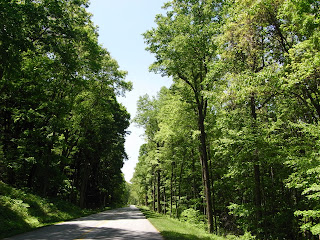26May2008 The Natural Bridge
We left Waynesboro and started our journey along the Blue Ridge Parkway from the north entrance. We visited a heritage museum comprising of log houses and other structures left by pioneers. It was really interesting to see how people lived a couple of centuries ago.
The highlight of the day undoubtedly was getting to see the Natural Bridge – a limestone arch carved by the waters of the Cedar Creek (a tributary of the James River) at least two hundred million years ago. It is over 215ft(66m)high (55ft higher than Niagara Falls), and the span is about 90ft(27m). At one time, locals even referred to it as one of the natural Seven Wonders of the World! George Washington, during his young days as a surveyor, was supposed to have done some done work here. Highway US11 still runs along the top of the arch – that’s how strong the solid grey limestone is!
It is annoying that one can only access this site at ground level by going through a gift shop and paying an entrance fee. Even so, it is still worthwhile see this natural wonder.
We spent the night in Best Western at Roanoke – a nondescript town along the BRP.
Distance traveled 169.7 miles

The Natural Bridge has been the subject of many artists. If one has a sense of deja vu when viewing these photos, the feeling may have come from visiting art galleries before.


Considering one doesn't get to stand directly under the Niagara Falls and this is 55ft taller, the size is awesome

The ancient 'Indians' called it the Bridge of God. Present day inhabitants of the town of Natural Bridge enact Biblical stories like the 'Drama of Creation', accompanied by symphonic music, with the floodlit 'Bridge' as backdrop. The seating for the performances can be seen.

Honey was often used in place of sugar and the early settlers had beehives in hollow trunks of gum trees - hence 'beegums'.

Into this contraption - a hopper - was dumped ashes from fires; water was poured on the ashes and the liquid that collected at the bottom - lye - was mixed with fat (from cooking) to make soap.

Hmm, interesting shaped squashes from the garden.

Part of the reconstructd narrow gauge railway used to ferry logs from deep in the mountains to the mills; the trees of the virgin forests were all but decimated by the logging companies from the early 1900's.

Along the Blue Ridge Parkway, we came upon a Green Geology Trail - a short walking detour giving those interested in the geology of the area a titbit; signs point out greenstone lava (igneous rocks),quartzite and schist (metamorphic rocks), limestone and sandstone (sedimentary rocks) when there are convenient outcroppings, road cuts or exposed cliffs.

Some say green is the most restful and soothing colour, our eyes smilingly agree.
The highlight of the day undoubtedly was getting to see the Natural Bridge – a limestone arch carved by the waters of the Cedar Creek (a tributary of the James River) at least two hundred million years ago. It is over 215ft(66m)high (55ft higher than Niagara Falls), and the span is about 90ft(27m). At one time, locals even referred to it as one of the natural Seven Wonders of the World! George Washington, during his young days as a surveyor, was supposed to have done some done work here. Highway US11 still runs along the top of the arch – that’s how strong the solid grey limestone is!
It is annoying that one can only access this site at ground level by going through a gift shop and paying an entrance fee. Even so, it is still worthwhile see this natural wonder.
We spent the night in Best Western at Roanoke – a nondescript town along the BRP.
Distance traveled 169.7 miles

The Natural Bridge has been the subject of many artists. If one has a sense of deja vu when viewing these photos, the feeling may have come from visiting art galleries before.


Considering one doesn't get to stand directly under the Niagara Falls and this is 55ft taller, the size is awesome

The ancient 'Indians' called it the Bridge of God. Present day inhabitants of the town of Natural Bridge enact Biblical stories like the 'Drama of Creation', accompanied by symphonic music, with the floodlit 'Bridge' as backdrop. The seating for the performances can be seen.

Honey was often used in place of sugar and the early settlers had beehives in hollow trunks of gum trees - hence 'beegums'.

Into this contraption - a hopper - was dumped ashes from fires; water was poured on the ashes and the liquid that collected at the bottom - lye - was mixed with fat (from cooking) to make soap.

Hmm, interesting shaped squashes from the garden.

Part of the reconstructd narrow gauge railway used to ferry logs from deep in the mountains to the mills; the trees of the virgin forests were all but decimated by the logging companies from the early 1900's.

Along the Blue Ridge Parkway, we came upon a Green Geology Trail - a short walking detour giving those interested in the geology of the area a titbit; signs point out greenstone lava (igneous rocks),quartzite and schist (metamorphic rocks), limestone and sandstone (sedimentary rocks) when there are convenient outcroppings, road cuts or exposed cliffs.

Some say green is the most restful and soothing colour, our eyes smilingly agree.

0 Comments:
Post a Comment
Subscribe to Post Comments [Atom]
<< Home